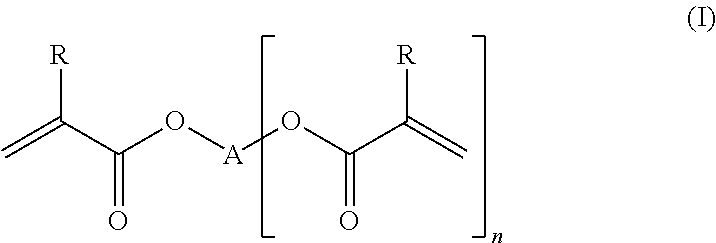Scratch-resistant-coated polycarbonates with high transparency, process for their production, and their use
a technology of polycarbonate substrate and scratch resistance, applied in the field of polycarbonate substrate coating process, can solve the problems of less hard than glass, lower scratch resistance and abrasion resistance, and lower resistance to external mechanical damage, so as to improve the appearance of the surface and improve the adhesion in the boil test
- Summary
- Abstract
- Description
- Claims
- Application Information
AI Technical Summary
Benefits of technology
Problems solved by technology
Method used
Image
Examples
##ventive example 1
Inventive Example 1
Production of a Coating B1 of the Invention
[0111]2.3 g of n-butanol, 13.31 g of isopropanol, 11.40 g of ethanol, 1.61 g of Tinuvin® 400 (85% strength in 1-methoxy-2-propanol) and 5.60 g of the unsaturated, sterically hindered amine (HALS L1-1) (50.8% strength in methyl ethyl ketone) are mixed in a flat-bottomed brown glass vessel. 0.27 g of Irgacure® 819 (commercially available photoinitiator from Ciba Specialty Chemicals; bis(2,4,6-trimethylbenzoyl)phenylphosphine oxide) and 1.1 g of Irgacure® 184 (commercially available photoinitiator from Ciba Specialty Chemicals; 1-hydroxycyclohexyl phenyl ketone) are then added, with stirring. 24.02 g of Desmolux® XP 2609 (unsaturated, aliphatic polyurethane acrylate from Bayer MaterialScience AG, 70% strength in hexanediol diacrylate (HDDA), density 1.14 g / cm3, viscosity @23° C. ˜6000 mPa*s), 0.4 g Byk UV 3570 (commercially available flow-control additive from Byk-Chemie GmbH, solution of a polyester-modified acrylic-functio...
##ventive example 4
Inventive Example 4
Production of Coating B4 of the Invention
[0123]3.25 g of n-butanol, 11.4 g of isopropanol, 6.80 g of ethanol, 2.80 g of ethyl acetate, 5.47 g of sterically hindered amine L1-1 (51.6% strength in MEK) and 6.18 g of UV absorber L2-1 (49.8% strength in MEK) are mixed in a flat-bottomed brown glass vessel. 0.27 g of Irgacure® 819 and 1.09 g of Irgacure® 184 are then added, with stirring. 9.74 g of Desmolux® VPLS 2308 (unsaturated, aliphatic polyurethane acrylate, 80% strength in hexanediol diacrylate (HDDA), density 1.11 g / cm3, viscosity@23° C. ˜29 000 mPa*s), 7.3 g SR 351 (commercially available trimethylolpropane triacrylate from Sartomer), 5.3 g of Ebercryl® 1290 (aliphatic polyurethane acrylate from Cytec, 100% strength, theoretical functionality 6, theoretical molecular weight 1000, density 1.19 g / cm3, viscosity@60° C. 2000 mPa*s), 0.4 g Byk UV 3570 (commercially available flow control additive from Byk-Chemie GmbH, solution of a polyester-modified acrylic-functi...
example 5
Production of Coating B5 of the Invention
[0124]3.00 g of n-butanol, 10.55 g of isopropanol, 6.30 g of ethanol, 2.64 g of ethyl acetate, 8.39 g of sterically hindered amine L1-2 (50.3% strength in methyl ethyl ketone) and 8.1 g of UV absorber L2-2 (58.7% strength in methyl ethyl ketone) are mixed in a flat-bottomed brown glass vessel. 0.270 g of Irgacure® 819 and 1.09 g of Irgacure® 184 are then added, with stirring. 8.4 g of Desmolux® VPLS 2308 (unsaturated, aliphatic polyurethane acrylate, 80% strength in hexanediol diacrylate (HDDA), density 1.11 g / cm3, viscosity@23° C. ˜29 000 mPa*s), 7.3 g SR 351 (commercially available trimethylolpropane triacrylate from Sartomer), 5.3 g of Ebercryl® 1290 (aliphatic polyurethane acrylate from Cytec, 100% strength, theoretical functionality 6, theoretical molecular weight 1000, density 1.19 g / cm3, viscosity@60° C. ˜2000 mPa*s), 0.4 g Byk UV 3570 (commercially available flow control additive from Byk-Chemie GmbH, solution of a polyester-modified ...
PUM
| Property | Measurement | Unit |
|---|---|---|
| particle size | aaaaa | aaaaa |
| yellowness | aaaaa | aaaaa |
| yellowness indices | aaaaa | aaaaa |
Abstract
Description
Claims
Application Information
 Login to View More
Login to View More - R&D
- Intellectual Property
- Life Sciences
- Materials
- Tech Scout
- Unparalleled Data Quality
- Higher Quality Content
- 60% Fewer Hallucinations
Browse by: Latest US Patents, China's latest patents, Technical Efficacy Thesaurus, Application Domain, Technology Topic, Popular Technical Reports.
© 2025 PatSnap. All rights reserved.Legal|Privacy policy|Modern Slavery Act Transparency Statement|Sitemap|About US| Contact US: help@patsnap.com

